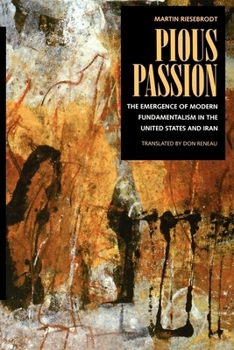Pious Passion: The Emergence of Modern Fundamentalism in the United States and Iran Volume 6
(Part of the Comparative Studies in Religion and Society Series)
Select Format
Select Condition 
Book Overview
Martin Riesebrodt's unconventional study provides an extraordinary look at religious fundamentalism. Comparing two seemingly disparate movements-in early twentieth-century United States and 1960s and 1970s Iran-he examines why these movements arose and developed. He sees them not simply as protests against "modernity" per se, but as a social and moral community's mobilization against its own marginalization and threats to its way of life. These movements protested against the hallmarks of industrialization and sought to transmit conservative cultural models to the next generation.
Fundamentalists desired a return to an "authentic" social order governed by God's law, one bound by patriarchal structures of authority and morality. Both movements advocated a strict gender dualism and were preoccupied with controlling the female body, which was viewed as the major threat to public morality.
Fundamentalists desired a return to an "authentic" social order governed by God's law, one bound by patriarchal structures of authority and morality. Both movements advocated a strict gender dualism and were preoccupied with controlling the female body, which was viewed as the major threat to public morality.
Format:Paperback
Language:English
ISBN:0520074645
ISBN13:9780520074644
Release Date:June 1998
Publisher:University of California Press
Length:276 Pages
Weight:0.99 lbs.
Dimensions:0.6" x 6.0" x 8.9"
Customer Reviews
1 rating
Sharp social analysis
Published by Thriftbooks.com User , 21 years ago
Riesebrodt compares social processes which gave birth to two so-called fundamentalist movements. He systematically and with quite great detail investigates similarities -- and differences -- between the contexts of these movements. The topic is handled without disturbing passion which this kind of politically sensitive subject easily raises. Results of the study are easily accessible and logical. This research doesn't leave room for needless guessing. A model example for cool, hard-working and honest social science.





